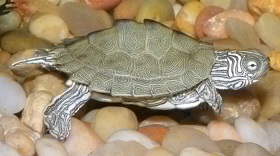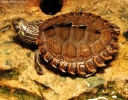Pascagoula Map Turtle (Graptemys gibbonsi)
Description: Pascagoula map turtles are a large species that exhibits significant sexual dimorphism, where females are over twice the size of males. Females have larger heads (megacephalic) with broader jaws compared to males. Males have longer tails with the vent posterior to the rim of the carapace, but lack the long that other Graptemys species possess. Females reach up to 11.6 inch carapace length at 7 lbs., while males reach 4.9 inches CL at 0.75 lbs.
Their head patterns consist of a large greenish interorbital blotch that connects to the two postorbital blotches behind each eye and yellow dorsal paramedian neck stripes. A three-pronged yellow blotch (nasal trident) is usually present on the dorsal head surface that extends towards the nose which occurs more frequently in turtles from Pearl River. The base coloring of their head and limbs is olive with yellow/yellow-green stripes and blotches. The olive, brown, or green carapace is relatively high-domed with a medial keel, which is composed of spines at the second and third vertebrals. A black stripe marks the median keel of the vertebrals. A vertical yellow or orange line is present on the dorsal surface of each marginal scute.
The yellow/orange pigment on the marginal scutes is compared to other members of the Alabama map turtle (Graptemys pulchra) species clade, of which Graptemys gibbonsi was once conspecific. The seams separating lower marginals contain dark borders that form one or two semicircles. Pleural scutes 1-3 have intersecting yellow markings on the distal parts. The plastron of these map turtles is pale yellow with dark markings at the seams.
Key features that distinguish this sympatric species from other map turtles are the presence/absence of a connection between the interorbital and postorbital blotches, nasal trident, supraoccipital spots, and curved or transverse chin bar. This species is labeled a confusing species because adult river cooters (Pseudemys concinna) and slider turtles (Trachemys scripta) are about the same size as female map turtles except for an enlarged head.
Pascagoula map turtle hatchlings are almost identical to adults except for vivid yellow and orange markings that fade with age. These marks are located on the costal scute on the carapace, and on the spines along the edge of the carapace. Their vertebral keels are sharper but dull with age. Females are estimated to reach maturity around the age 15–20 years. Males are estimated to reach maturity at a younger age, possibly as young as four years.
Habitat: Map turtles are only found in large to medium-sized rivers less than 20 m wide with an abundance of basking logs and mollusks, usually in deep, flowing currents. They are typically found in bodies of water with sand or gravel bottoms and clear waters; polluted water conditions are avoided. A sandy beach nesting site is required for them to have offspring.
They spend most of their time basking on logs, floating branches, crowns, and tangles. Basking durations occurred more in the spring in fall versus summer, and longer during morning and evening periods. Females generally basked on larger, stronger logs while males basked on smaller branches. Deadwood “snags” lined against the outer bends of a river are used for several purposes. They serve as a basking site, a substrate while nesting or sleeping, or a grazing substrate for juveniles and males. Juveniles and adults reside in the same habitat most of their lives. Nesting sites include islands, lake shores, sandbars deposited inside river bends, wooded riparian margin of the river in a forest.
Range: The Pascagoula map turtle is restricted to the Pascagoula River in the United States. It formerly included a population in the Pearl River, but in 2010, that population was described as a separate species, the Pearl River map turtle, Graptemys pearlensis. The Pascagoula map turtle shares its range with the yellow-blotched map turtle, G. flavimaculata.
Found in these States:
LA |
MS
Diet: Pascagoula map turtles are both insectivorous and molluscivorous and feed both in aquatic and terrestrial environments. Males of this species feed on caddisfly larvae, Asian clams (Corbicula fluminea), sponges, moss, algal stalks, and leaf fragments. Larger females eat large mussels and snails. Lower amounts of caddisfly larvae, insect fragments, wood fragments, leaf fragments, and algal stalks are also found in females’ diets. Wood fragments were found in the diets of males but not females; it has been suggested that males likely eat along deadwood structures and females probably forage on river bottoms.
Reproduction: When male Pascagoula map turtles are trying to mate with females, they put their nose at the female’s cloaca, then slant their neck towards the female and starts bobbing their head up and down. This stimulates the female. Sometimes the males don’t engage in courtship and just mount the females. This species is monogamous.
Peak nesting seasons are April to July. The long reproductive season suggests females lay more than one clutch per year. Females are pregnant during late spring, and egg laying occurs from April to August. Gestation periods are usually 3 to 4 months long. Clutches generally include 5 to 9 offspring (average = 7.5). Their mean egg widths are 1 inch, and mean lengths are 1.5 inches. Hatchlings emerge late summer to early fall. Their birth mass ranges from 0.35 to 0.45 ounces (average = 0.4 ounces). Hatchlings experience little, if any, growth prior to hibernation. The average plastron length (PL) for hatchlings ranges from 1.08 to 1,3 inches. As soon as they leave the nest, they are considered independent.
Male map turtles reach maturity at age of 4 to 5, while females don’t mature until they are 6 to 18 years old. Females are larger at maturity to complement their high fecundity rate and allow them to withstand encounters with large predators while nesting. Males mature earlier at smaller sizes because they lack pressures that the females encounter.
Nesting sites include islands, lake shores, sandbars deposited inside river bends, and wooded riparian margins of the river in a forest. They don’t stray far from water. Females may group at the nesting beaches hours before laying eggs. The females press their snouts to the ground and may scratch the sand with their forenails to form a nesting hole. Defecation may moisten the substrate and continue packing sand so the cavity doesn’t break. The cavities are dug by hind feet movement. The deposition of eggs come in 1 to 2-minute intervals and are laid in 2 to 3 layers which are positioned by altering hind feet movement. The nests are usually completed in under an hour.
After laying the eggs, the females use their feet to pack the soil around the eggs and smooth the surface before returning to the water. They will sometimes begin then abandon their nests mid-digging due to any sort of obvious obstruction, such as a plant root or a rock in the way, or a storm. Aborted “desperation nests” are usually left with 1 to 2 eggs.
Status: Pascagoula map turtles are listed as “Endangered” under the IUCN Red List, with a descending population trend. It states that they are protected from commercial exploitation in Mississippi and possession is limited to four individuals. It has been included in CITES Appendix III (United States) since June 14th, 2006. This means that international trade (primarily pet trade but also in foreign meat markets) requires export permits that identify the turtles’ species and ensures that the trade is not in violation of any federal or state laws. These turtles have been suggested to qualify for inclusion as threatened under the Endangered Species Act (ESA). There was no special status listed under the US Federal or the State of Michigan sites.
Threats to Pascagoula map turtles include human disturbances such as mining and quarrying, log harvesting, dams and water management, domestic and urban waste water, and industrial and military waste. Removal of logs, snags, and channelization of rivers eliminates basking sites and nesting beaches that are essential for the survival of this turtle species. Weather related threats include climate change, storms and flooding. Nesting habitat becomes limited due to storms and flooding.
»» Kingdom: Animalia - Animals
»» Phylum: Chordata - Chordates
»» Subphylum: Vertebrata - Vertebrates
»» Class: Reptilia - Reptiles
»» Order: Testudines - Turtles & Tortoises
»» Family: Emydidae - Pond, Marsh, & Box Turtles
»» Genus: Graptemys
»» Species: Graptemys gibbonsi - Pascagoula Map Turtle
»» Subspecies: None
This article uses material from the Wikipedia article "Pascagoula Map Turtle", which is released under the Creative Commons Attribution-Share-Alike License 3.0. Content may have been omitted from the original, but no content has been changed or extended.
|







